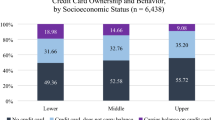Abstract
This paper employs Tobit to estimate retentionprobabilities and credit hours at two universities. Theinnovation is that this technique examines credit-hourchoice with the decision to depart the university treated as the choice of zero credit hours.Tobit is appropriate for this problem because itrecognizes the lower bound of zero on credit hours andincorporates this bound into the parameter estimates and forecasts. Models are estimated for credithours in a single year and cumulative hours over asix-year horizon.
Similar content being viewed by others
REFERENCES
Amemiya. Takeshi (1984). Tobit models: A survey. Journal of Econometrics24: 3±61.
Bean, John P. (1980). Dropouts and turnover: The synthesis and test of a causal model of student attrition. Research in Higher Education12(2): 155±187.
Bean, John P. (1983). The application of the turnover model in work organizations to the student attrition process. Review of Higher Education6(2): 129±148.
Bean, John P. (1990). Why students leave: Insights from research. In Don Hossler and John P. Bean (eds.), The Strategic Management of College Enrollments(pp. 147±169). San Francisco: Jossey-Bass.
Bean, John P., and Metzner, B. S. (1985). A conceptual model of nontraditional undergraduate student attrition. Review of Educational Research55(4): 485±540.
Braxton, John M., Vesper, Nick, and Hossler, Don (1995). Expectations for college and student persistence. Research in Higher Education36(5): 595±612.
Cabrera, Alberto F. (1994). Logistic regression analysis in higher education: An applied perspective. In John C. Smart (ed.), Higher Education: Handbook of Theory and Research, vol. 10 (pp. 225±256). New York: Agathon Press.
Davidson, Russell, and MacKinnon, James G. (1993). Estimation and Inference in Econometrics. New York: Oxford University Press.
Judge, George G., Griffiths, William E., Hill, R. Carter, and Lee, Tsoung-Chao (1980). The Theory and Practice of Econometrics. New York: John Wiley and Sons.
Judge, George G., Hill, R. Carter, Griffiths, William E., Lütkepohl, Helmut, and Lee, Tsoung-Chao (1982). Introduction to the Theory and Practice of Econometrics. New York: John Wiley and Sons.
Nora, Amaury, Cabrera, Alberto, Hagedorn, Linda Serra, and Pascarella, Ernest (1996). Differential impacts of academic and social experiences on college-related behavioral outcomes across different ethnic and gender groups at four-year institutions. Research in Higher Education37(4): 427±451.
St. John, Edward P. (1990). Price response in persistence decisions: An analysis of the high school and beyond senior cohort. Research in Higher Education31(4): 387±403.
St. John, Edward P., Kirshstein, Rita J., and Noell, Jay (1991). The effects of student financial aid on persistence: A sequential analysis. Review of Higher Education14(3): 383±406.
Spady, W. (1970). Dropouts from higher education: An interdisciplinary review and synthesis. Interchange1:64±85.
Tinto, Vincent (1975). Dropouts from higher education: A theoretical synthesis of recent research. Review of Educational Research45(1): 89±125.
Tobin, James (1958). Estimation of relationships for limited dependent variables. Econometrica26(1): 24±36.
Rights and permissions
About this article
Cite this article
Bivin, D., Rooney, P.M. FORECASTING CREDIT HOURS. Research in Higher Education 40, 613–632 (1999). https://doi.org/10.1023/A:1018704712802
Issue Date:
DOI: https://doi.org/10.1023/A:1018704712802




